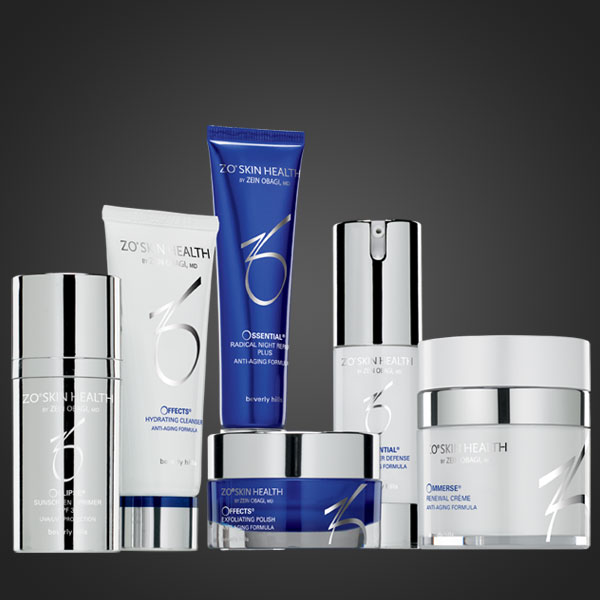Skin Care – Zein Obagi


The use of face creams, cleansers and scrubs in the pursuit of younger looking skin is a multi billion pound industry and influenced heavily by industry marketing and celebrity endorsements. Unfortunately our choice of creams to use on our face is not evidence based – there is no scientific evidence to prove its efficacy. As a result often we are left disappointed with the results and find ourselves moving from product to product and brand to brand. Good skin is considered to be smooth, even in colour, firm and tight, well hydrated, tolerant, contour rich and free of active disease. Do you have good skin?
How does skin change over the years?
By the age of 30 our skin often enters an inactive phase and the complex machinery of maintaining good skin that is hard at work in our younger years starts to grind to a halt. This results in irregular skin cell function, weakened and impaired barrier function, changes in skin texture and laxity and wrinkles as a result of damage to existing collagen and elastin alongside reduced production. Despite the effects of ageing, it is possible to keep the skin functioning properly throughout life.
Rejuvence Philosophy
At Rejuvence we have a thorough understanding of essential and supportive agents necessary in an effective skin care program. We are also great believers in only using products that have been scientifically proven to work. Hence we specialise in the prescription and use of products from the Zein Obagi line. All ZO products are based around the use of essential and supportive components and have yielded excellent results. We recommend all our clients change their daily skin care regime to ZO and we are sure they won’t be disappointed.

Ideally, before commencing any skin care products, you should research and analyse the component ingredients to ensure that only products proved to be beneficial and therapeutic are used. Unfortunately this can be overwhelming especially since there is so much unclear and misleading information. It is important to realise that the majority of products provide quick gratification through looking, smelling and feeling good. However, they yield no visible or lasting benefit. Often components used to make products comfortable are counterproductive for your skin. Unfortunately most currently marketed anti-ageing products are useless and do not deliver. This is usually because their active ingredient is ineffective, too low in concentration or too large a molecule to penetrate the skin.
There are a core group of essential components that have been scientifically shown in multiple studies to have beneficial effects. These components are the only known substances that have been shown to be able to return skin to its best possible original state. These essential components have a number of effects. They enhance natural exfoliation of the skin. They ensure proper barrier function by way of restoring the correct balance between water, lipids and protein in the skin. They even the colour tone of the skin. They stimulate the repair and production of new collagen and elastin to improve skin vitality, lines and wrinkles. They improve hydration of the skin by increasing the production of glycosaminoglycans such as hyaluronic acid as well as repair DNA.
The most common essential components of any beneficial skin care package are vitamin A derivatives including tretinoin and retinol, hydroquinone, antioxidants, DNA repair agents, anti-inflammatory agents and growth factors.
Tretinoin benefits both the upper and deeper layers of the skin. It repairs damaged epidermal cells and improves natural hydration as well increase epidermal thickness. In the deeper dermis tretinoin increases collagen and elastin as well as hyaluronic acid. The higher the strength of tretinoin, the deeper it penetrates, the more impressive are its effects. However, it is associated with initial peeling and redness that requires a few weeks to get used. Retinol is less irritating but not as potent.
Hydroquinone prevents the formation of new melanin and is used to treat pigmentation problems. The effectiveness of hydroquinone is further enhanced when combined with tretinoin. It has a bleaching effect when used in isolation. It has a blending effect when used in combination with tretinoin to help even out colour tone.
As a byproduct of certain cellular activities free radicals are produced and can trigger a series of reactions that can cause cell damage. Antioxidants remove these free radicals and limit the extent of any damage. Examples of antioxidants are alpha-lipoid acid, glutathione, idebenone, ubiquinone, vitamin C, vitamin E and vitamin B.
Ageing is believed to be a consequence of an accumulation of unprepared naturally occurring DNA damage. DNA repair agents include Oxo-guanine glycosylase-1, Ultraviolet endonuclease, Photolyase, Natural DNA repair precursors.
Growth factors have been shown to repair photo damage. However, there is controversy associated with the use of products containing human growth factors where as non-human and synthetically sourced growth factors have much better safety profiles.
There are a series of well recognised components that have are considered mildly therapeutic and have been shown to be very effective when used in combination with essential agents. Supportive agents include alpha-hydroxy acids, beta-hydroxy acids, non-hydroquinone pigment-stabilising agents and disease specific agents.













